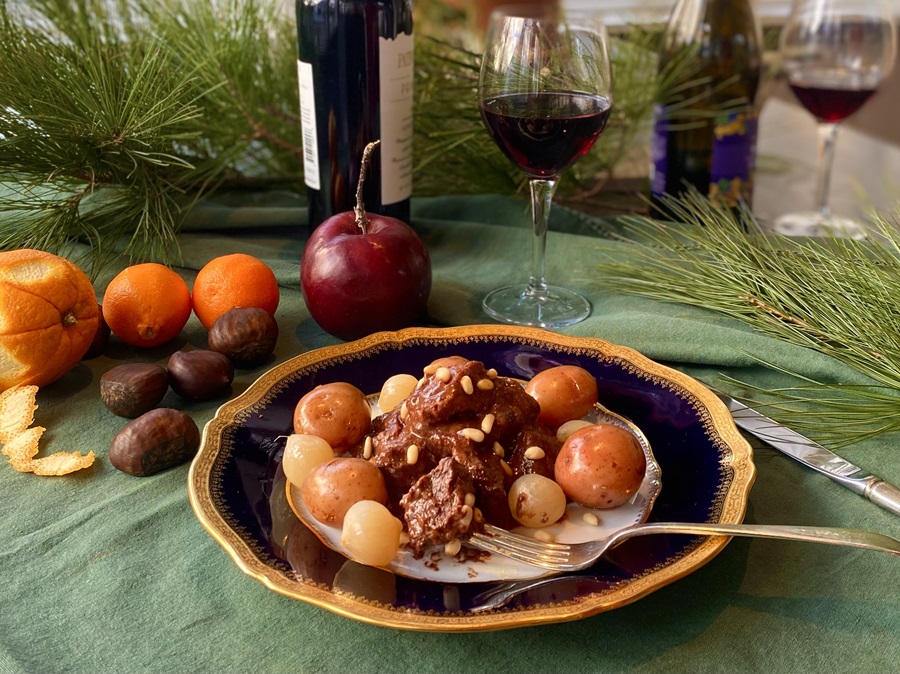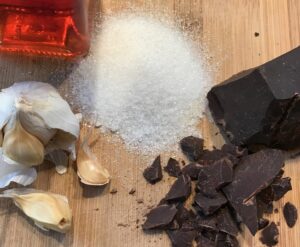Most everyone who loves to cook has probably gone over the top at least once and created a feast of embarrassing excess. My long-ago decadent dinner began as an unlikely work assignment — I was working in publishing — testing recipes for an Italian Renaissance feast. It would have to include wild boar.
I turned to Hugo for help, not because he’s Italian, but because he would know where to score wild game (but that’s another story).
When the wild boar arrived, by air express, I felt a twinge of conscience. I suppose I was glad we don’t have a lot of feral hogs roaming the Cape, but this luxe pig, neatly portioned, sealed in plastic, and embedded in ice packs was too much.

Hugo’s enthusiasm carried us forward, though, and we proceeded to test the recipes, which included, besides the boar, fish in aspic and cipolline onions with raisins and black pepper. In the 1500s, spices rather than herbs were used for aroma and flavor.
As for the boar, it was braised in familiar wine and aromatics, but the sauce also included vinegar and prunes along with juniper berries, bay leaf, and pine nuts. It was an agrodolce — literally bitter and sweet, now better known as sweet-and-sour — a combination seen across southern Europe and said to have originated in North African Arab cooking. Evidently, agrodolce made its way to Sicily and then Rome before proceeding north, where it became a Florentine favorite.
The feast was memorable. So much so that Hugo and I recreated it to cheer up dear friends, and of course ourselves, during the winter of 2021. Normally Chris and John only spend summers on Cape Cod, but they’d been lying low here through the pandemic and into that winter. We’d been more than happy to have extra time with them, putting on dinners in the back yard. John, who has summered on the Cape since the 1940s, had taught us so much about local lore and customs, including how to make his signature beach plum brandy.
Our plan was to reprise the Renaissance meal out by the firepit, but a frigid wind blew in, so after drinks outdoors, we packed dinner for them to take home. We stayed home and dined indoors, and later, we compared our experiences of the decadent dinner by phone.
Even with that, the feast made an impression, and the memory lingers. A few weeks ago, Chris reminded us about it. Should we do it again this winter?

My conscience would not permit the flown-in boar this time. So, I created a version that is less demanding of the planet’s resources, supports local farming, and is every bit as delectable. It begins with heritage pork raised a few miles from our house on Tim Friary’s Cape Cod Organic Farm. Wild game aficionados will detect a milder flavor to the pork loin that replaces wild boar. But the sauce remains exactly the same.
The sweet-and-sour of the agrodolce is created with vinegar and sugar, and bitter chocolate adds a mysterious deeper note to the dish. Serve it with boiled or roasted pearl onions and new potatoes. And to give the whole experience a decidedly over the top old-world aura, fish would be a fitting first course. For dessert, almond cake, cannoli, fruit, nuts, and cheese are traditional. Probably just one of those would be enough.
PORK LOIN AGRODOLCE
Makes 6 servings
2 pounds pork loin, cut into 1-inch cubes
1 bottle dry red wine
½ cup flour
1/3 cup olive oil
2 medium onions, chopped
1 carrot, chopped
1 celery stalk, chopped
2 bay leaves
2 tsp. juniper berries
Big pinch salt
½ tsp. black pepper
3 garlic cloves, chopped
¼ cup sugar
2 Tbsp. water
1/3 cup wine vinegar
2 oz. bitter chocolate, grated
¾ cup prunes, pitted
¼ cup pine nuts
- Place the meat in a glass bowl, add two-thirds of the red wine, and marinate, refrigerated, for about four hours.
- Remove pork from the marinade and pat it dry before dusting it with flour. In a flameproof casserole, sauté the onion, carrot, and celery in olive oil briefly before adding the pork. Raise the heat and cook, stirring several times, until the meat is just browned. Add the bay leaves, juniper berries, salt to taste, and pepper. Pour the marinade over the pork and vegetables.
- Set the cooking pot, covered, to gently simmer for about 40 minutes, or until the meat is fork tender. If it begins to dry, add more wine. Meanwhile, toast the pine nuts and finish preparing the sauce.
- In a small skillet, toast the pine nuts, shaking or stirring them in the pan for just a few minutes — they go from golden to burned very quickly. Set aside.
- In a small saucepan, stir together the garlic, sugar, and water, cooking over low heat until the sugar bubbles and turns amber. Add the vinegar and chocolate and stir as it cooks for a few minutes more to melt the chocolate.
- Combine the sauce with the finished stew and add the prunes. Taste for seasoning. Simmer slowly for 5 to 10 minutes to thoroughly heat the dish and serve it with the pine nuts sprinkled on top.



